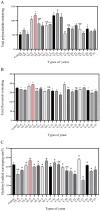Preparation of safflower fermentation solution and study on its biological activity
- PMID: 39539711
- PMCID: PMC11557484
- DOI: 10.3389/fmicb.2024.1472992
Preparation of safflower fermentation solution and study on its biological activity
Abstract
Introduction: Safflower, a traditional Chinese medicine, is rich in chemical components including flavonoids, polysaccharides, and alkaloids. It exhibits pharmacological effects such as antioxidant, anti-inflammatory, anti-tumor, and anti-thrombosis properties, making it a valuable resource in the medical field. Furthermore, due to its antioxidant and anti-inflammatory effects, safflower is increasingly being utilized in the cosmetics industry.
Methods: In this study, yeast was employed to ferment safflower, and the optimal fermentation conditions were established through single-factor experiments and response surface methodology. Subsequently, the antioxidant and anti-inflammatory efficacy of the safflower fermentation solution was assessed using both cellular and zebrafish models. Finally, the safety of the safflower fermentation solution was evaluated through a cosmetic eye irritation test.
Results: From a total of 20 yeast strains, YF-5 was identified as the dominant strain for safflower fermentation. By optimizing the fermentation conditions, it was established that the optimal parameters for YF-5 fermentation of safflower are as follows: a fermentation temperature of 36.55°C, a material-to-liquid ratio of 1:20.46, a fructose concentration of 6.20%, a fermentation duration of 72 h, and an inoculum volume of 4%. The biological activities of safflower, including its antioxidant and anti-inflammatory properties, were enhanced through yeast fermentation. In HaCaT cell and zebrafish oxidative damage assays, safflower fermentation solution inhibits the production of malondialdehyde (MDA) and increases superoxide dismutase (SOD) activity as well as total antioxidant capacity (T-AOC). In the RAW264.7 cell inflammatory damage assays, a 20% safflower fermentation solution was found to inhibit the release of TNF-α and NO in the inflammatory model, with inhibition rates of 30.94 and 28.86%, respectively. In the zebrafish inflammatory damage assays, the quantity of fluorescent neutral proteins in the 5% safflower fermentation solution was 0.7 times that observed in the dexamethasone (0.1 mg/mL) positive control group, indicating that its anti-inflammatory activity is comparable to that of dexamethasone (0.1 mg/mL). In the chicken embryo chorionic membrane experiment, it was observed that the safflower fermentation solution did not cause significant damage to the blood vessels of the chorionic allantoic membrane (CAM). This finding demonstrates that the safflower fermentation solution possesses a certain degree of safety.
Discussion: Safflower fermentation solution has antioxidant and anti-inflammatory bioactivities, and it has passed cosmetic safety evaluations. It can be used as a new natural cosmetic ingredient added to cosmetic products.
Keywords: anti-inflammatory; antioxidant; fermentation; safflower; yeast.
Copyright © 2024 Tang, Xu, Guo, Meng, Qian and Li.
Conflict of interest statement
The authors declare that the research was conducted in the absence of any commercial or financial relationships that could be construed as a potential conflict of interest.
Figures







Similar articles
-
Mitigation of oxidative stress and inflammatory factors, along with the antibrowning and antimicrobial effects of cassia seed microbial fermentation solution.Front Microbiol. 2024 May 9;15:1400505. doi: 10.3389/fmicb.2024.1400505. eCollection 2024. Front Microbiol. 2024. PMID: 38784817 Free PMC article.
-
Evaluation of cosmetic efficacy of lychee seed fermentation liquid.Bioresour Bioprocess. 2024 Oct 31;11(1):104. doi: 10.1186/s40643-024-00818-9. Bioresour Bioprocess. 2024. PMID: 39480640 Free PMC article.
-
Grape skin fermentation by Lactobacillus fermentum CQPC04 has anti-oxidative effects on human embryonic kidney cells and apoptosis-promoting effects on human hepatoma cells.RSC Adv. 2020 Jan 29;10(8):4607-4620. doi: 10.1039/c9ra09863a. eCollection 2020 Jan 24. RSC Adv. 2020. PMID: 35495273 Free PMC article.
-
Final report on the safety assessment of capsicum annuum extract, capsicum annuum fruit extract, capsicum annuum resin, capsicum annuum fruit powder, capsicum frutescens fruit, capsicum frutescens fruit extract, capsicum frutescens resin, and capsaicin.Int J Toxicol. 2007;26 Suppl 1:3-106. doi: 10.1080/10915810601163939. Int J Toxicol. 2007. PMID: 17365137 Review.
-
Antioxidant Properties and Diet-Related α-Glucosidase and Lipase Inhibitory Activities of Yogurt Supplemented with Safflower (Carthamus tinctorius L.) Petal Extract.Food Sci Anim Resour. 2021 Jan;41(1):122-134. doi: 10.5851/kosfa.2020.e88. Epub 2021 Jan 1. Food Sci Anim Resour. 2021. PMID: 33506222 Free PMC article. Review.
Cited by
-
Study on Fermentation Preparation, Stability, and Angiotensin-Converting Enzyme Inhibitory Activity of Tomato Pomace Peptide.Foods. 2025 Jan 7;14(2):145. doi: 10.3390/foods14020145. Foods. 2025. PMID: 39856812 Free PMC article.
References
-
- Abduxukur D., Tursuntay A., Zhu X., Wang X., Rahman N. (2023). Antioxidant capacity of lactic acid bacteria and yeasts from Xinjiang traditional fermented dairy products. Fermentation 9, 9:639. doi: 10.3390/fermentation9070639 - DOI
-
- Bing-sheng Y. (2012). UV spectrophotometric measurement of total flavonoids in citrus peels. Chem. Environ. Sci.
-
- Chen Y., Xiang Q., Peng F., Gao S., Yu L., Tang Y., et al. . (2023). The mechanism of action of safflower total flavonoids in the treatment of endometritis caused by incomplete abortion based on network pharmacology and 16S rDNA sequencing. J. Ethnopharmacol. 315:116639. doi: 10.1016/j.jep.2023.116639 - DOI - PubMed
LinkOut - more resources
Full Text Sources

